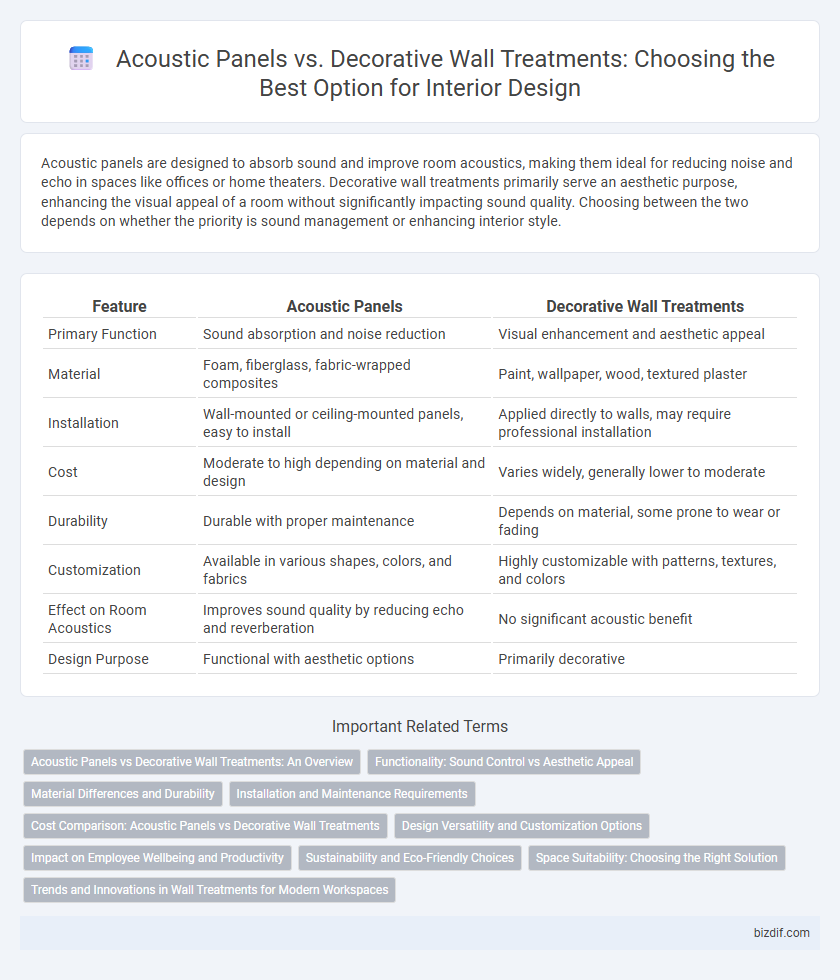Acoustic panels are designed to absorb sound and improve room acoustics, making them ideal for reducing noise and echo in spaces like offices or home theaters. Decorative wall treatments primarily serve an aesthetic purpose, enhancing the visual appeal of a room without significantly impacting sound quality. Choosing between the two depends on whether the priority is sound management or enhancing interior style.
Table of Comparison
| Feature | Acoustic Panels | Decorative Wall Treatments |
|---|---|---|
| Primary Function | Sound absorption and noise reduction | Visual enhancement and aesthetic appeal |
| Material | Foam, fiberglass, fabric-wrapped composites | Paint, wallpaper, wood, textured plaster |
| Installation | Wall-mounted or ceiling-mounted panels, easy to install | Applied directly to walls, may require professional installation |
| Cost | Moderate to high depending on material and design | Varies widely, generally lower to moderate |
| Durability | Durable with proper maintenance | Depends on material, some prone to wear or fading |
| Customization | Available in various shapes, colors, and fabrics | Highly customizable with patterns, textures, and colors |
| Effect on Room Acoustics | Improves sound quality by reducing echo and reverberation | No significant acoustic benefit |
| Design Purpose | Functional with aesthetic options | Primarily decorative |
Acoustic Panels vs Decorative Wall Treatments: An Overview
Acoustic panels offer superior sound absorption properties, significantly reducing echo and noise levels, making them ideal for improving room acoustics. Decorative wall treatments primarily enhance visual appeal but lack the functional soundproofing benefits found in acoustic panels. Selecting acoustic panels ensures both aesthetic enhancement and effective acoustic performance for interior spaces.
Functionality: Sound Control vs Aesthetic Appeal
Acoustic panels are engineered specifically to absorb sound and reduce noise, providing efficient sound control in interior spaces such as offices, studios, and home theaters. Decorative wall treatments primarily enhance aesthetic appeal, offering visual interest through textures, patterns, and colors but lack significant sound absorption properties. Balancing acoustic performance and design, many modern panels integrate aesthetic elements to serve dual purposes in contemporary interior design.
Material Differences and Durability
Acoustic panels are typically made from sound-absorbing materials like fiberglass, foam, or mineral wool, designed to reduce noise and improve sound quality, whereas decorative wall treatments use materials such as wallpaper, wood, or fabric primarily for aesthetic appeal. The dense, porous structure of acoustic panels ensures effective sound dampening and long-term durability, while decorative treatments may be less resistant to wear, moisture, and damage over time. Durability of acoustic panels generally surpasses that of decorative wall treatments, making them a practical choice for both functional and design-oriented interior spaces.
Installation and Maintenance Requirements
Acoustic panels typically require precise mounting to ensure optimal sound absorption, involving anchors or velcro systems, and may demand professional installation for larger or irregularly shaped spaces. Decorative wall treatments are generally easier to install, often using adhesives, nails, or clips, allowing for quicker and more flexible setups. Maintenance of acoustic panels focuses on dusting and occasional fabric cleaning, while decorative wall treatments may require more frequent upkeep depending on material, such as repainting or touch-ups.
Cost Comparison: Acoustic Panels vs Decorative Wall Treatments
Acoustic panels typically range from $30 to $100 per panel, offering effective sound absorption and reducing noise levels in interior spaces, whereas decorative wall treatments like wallpaper or textured finishes usually cost between $2 to $10 per square foot but lack significant acoustic benefits. The installation cost for acoustic panels can be higher due to specialized mounting requirements, often between $50 and $150 per hour for professionals, while decorative treatments generally demand less labor-intensive application, lowering overall expenses. Selecting between these options depends on budget constraints and the primary goal of either enhancing aesthetics or improving acoustic performance.
Design Versatility and Customization Options
Acoustic panels offer superior design versatility with customizable shapes, sizes, and fabric options tailored to enhance sound quality while complementing interior aesthetics. Decorative wall treatments provide a wide range of textures, patterns, and finishes but lack the functional sound absorption capabilities of acoustic solutions. Choosing between the two depends on whether the priority is acoustic performance combined with design flexibility or purely visual impact.
Impact on Employee Wellbeing and Productivity
Acoustic panels significantly reduce noise distractions, enhancing concentration and reducing stress levels, which directly boosts employee wellbeing and productivity in open office environments. Decorative wall treatments, while visually appealing and contributing to a pleasant workspace, generally offer limited sound absorption benefits compared to acoustic panels. Integrating acoustic panels ensures a quieter, more comfortable atmosphere conducive to sustained focus and mental clarity for employees.
Sustainability and Eco-Friendly Choices
Acoustic panels made from recycled fibers and natural materials offer superior sound absorption while reducing environmental impact compared to traditional decorative wall treatments. Sustainable options such as cork, wool, and bamboo acoustic panels enhance indoor air quality and contribute to LEED certification. Choosing eco-friendly acoustic solutions supports waste reduction and energy efficiency in interior design projects.
Space Suitability: Choosing the Right Solution
Acoustic panels are ideal for spaces requiring sound absorption, such as home theaters, offices, and recording studios, where noise control and clarity are paramount. Decorative wall treatments enhance aesthetics and texture without significantly affecting sound quality, making them suitable for living rooms, galleries, and hotels focused on visual appeal. Selecting the right solution depends on balancing acoustic performance needs with design goals and the specific functional demands of the space.
Trends and Innovations in Wall Treatments for Modern Workspaces
Acoustic panels in modern workspaces prioritize sound absorption and noise reduction, utilizing advanced materials like recycled PET fibers and customizable digital prints for both functionality and aesthetic appeal. Decorative wall treatments increasingly incorporate multifunctional elements such as integrated lighting and 3D textures, merging artistic design with practical workspace enhancement. Innovations like modular panel systems and smart materials that adapt to environmental changes are setting new standards in creating dynamic, productive office environments.
Acoustic panels vs Decorative wall treatments Infographic

 bizdif.com
bizdif.com